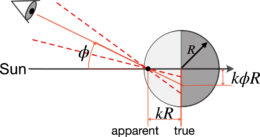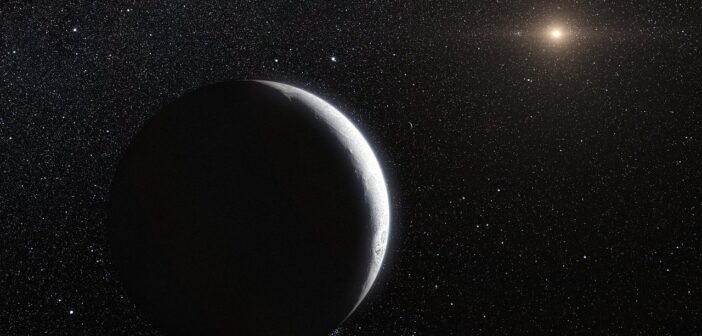Editor’s Note: Astrobites is a graduate-student-run organization that digests astrophysical literature for undergraduate students. As part of the partnership between the AAS and astrobites, we occasionally repost astrobites content here at AAS Nova. We hope you enjoy this post from astrobites; the original can be viewed at astrobites.org.
Title: Can the Gravitational Effect of Planet X be Detected in Current-era Tracking of the Known Major and Minor Planets?
Authors: Daniel C. H. Gomes et al.
First Author’s Institution: University of Pennsylvania
Status: Published in PSJ
Even though astronomy deals with profound questions about the universe that resonate with the public, it’s no secret that most open questions in astronomy require a hefty dose of context to explain. The cutting edge is necessarily convoluted: the vast majority of scientific progress is made when nibbling at the edges, and as a field we are lucky that our intermediate data products are pretty enough to appear on the front page news without an accompanying treatise on the true topics of interest like redshift, inflation, dark matter, and more.
In this context, the pure simplicity of the question at the center of the Planet Nine debate is almost charming: is there another giant planet lurking at the edges of our solar system, one that we just haven’t seen yet? Some say yes, pulling from observations of trans-Neptunian objects that seem to travel on aligned orbits, possibly shepherded by a stealthy attendant planet. Others say no, and they claim either that the noted alignment is actually a mirage, the manifestation of observational biases, or that it’s real but caused by something else. Who is correct remains unclear, since although astronomers haven’t found such a planet yet, doing so would require overcoming immense observational challenges.
Alternative Solutions
If it’s real, this prowling giant (which some refer to as Planet Nine, and others as Planet X) would be so far away, so faint, and so slow, that its discovery will likely require large telescopes, enormous cameras, and a decent amount of luck. Finding something more than 10 times more distant with Neptune is hard; the community therefore has a strong motivation to consider “alternative” ways to find or rule out this purported planet.
Enter today’s article, led by graduate student Daniel C. H. Gomes of the University of Pennsylvania. This exhaustive yet enjoyable 41-page juggernaut joins a growing literature focused on these “alternative” searches. Instead of trying to uncover Planet X’s hiding spot directly, the authors wonder if it might give itself away via its influence on the rest of the solar system.
Planet Ranging

Figure 1: The accuracy with which we could measure the mass of an object sitting at 400 au from the Sun as a function of its position on the sky. Since a “confident detection” generally requires measuring something with a precision five times smaller than the value in question, a 5-Earth-mass planet could be detectable everywhere smaller than σM = 1 here. Click to enlarge. [Adapted from Gomes et al. 2023]
They find that by including all of the data from the Juno, Cassini, and various Mars missions, we could in principle conclusively detect a 5-Earth-mass planet sitting at 400 au anywhere within 99.2% of the sky. That’s a startlingly strong constraint, and on its face potentially bad news for the reality of Planet X since previous searches have turned up empty. However, its resurrection lies in the subtleties and assumptions. If the planet were instead farther out, at say 800 au, we would only be able to detect it if it sat in a very special pocket spanning just 4.8% of the sky. Alternatively, if it were less massive than the inferred super-Earth value, it would have to sit closer in than the nominal 400 au to be revealed by the ranging data.
Future Prospects
After demonstrating the usefulness of historical ranging data in the first half of the article, the authors barely pause before tackling a related but distinct question: will we be able to place even stronger constraints on the mass and position of any distant planets using future measurements? In particular, they consider the thousands of Jupiter trojans that will be observed by the upcoming Legacy Survey of Space and Time (LSST). Might careful tracking of these tiny objects reveal Planet X?

Figure 2: An illustration of one of the complications with making extremely precise measurements of a trojan’s position. We see light coming from the photocenter, but the true center of the object, its barycenter, is offset from this by an amount that depends on the shape of the object. This distance is often comparable to the offset caused by Planet X. [Gomes et al. 2023]
So, does Planet X exist? Still maybe, but it likely has fewer places to hide now. Between studies like this one that creatively consider the consequences of a distant planet and the direct searches for it, astronomers are pinching closed the parameter space in which it could live.
Original astrobite edited by Macy Huston.
About the author, Ben Cassese:
I am a second-year Astronomy PhD student at Columbia University working on simulated observations of exomoons. Prior to joining the Cool Worlds Lab I studied planetary science and history at Caltech, and before that I grew up in Rhode Island. In my free time I enjoy backpacking, spending too much effort on making coffee, and daydreaming about adopting a dog in my NYC apartment.

